Effects of Different Air Particle Abrasion Protocols on the Biaxial Flexural Strength and Fractography of High/Ultra-Translucent Zirconia
Abstract
:1. Introduction
2. Materials and Methods
2.1. Preparation of the Samples
2.2. Biaxial Flexural Strength (BFS)
2.3. Fractographic Analysis
2.4. Statistical Analysis
3. Results
3.1. Biaxial Flexural Strength (BFS) Testing
3.2. Fractographic Analysis
4. Discussion
5. Conclusions
Author Contributions
Funding
Institutional Review Board Statement
Informed Consent Statement
Data Availability Statement
Acknowledgments
Conflicts of Interest
References
- Yoshida, K. Influence of alumina air-abrasion for highly translucent partially stabilized zirconia on flexural strength, surface properties, and bond strength of resin cement. J. Appl. Oral Sci. 2020, 28, e20190371. [Google Scholar] [CrossRef]
- Zhang, X.; Liang, W.; Jiang, F.; Wang, Z.; Zhao, J.; Zhou, C.; Wu, J. Effects of air-abrasion pressure on mechanical and bonding properties of translucent zirconia. Clin. Oral Investig. 2020, 25, 1979–1988. [Google Scholar] [CrossRef]
- Rinke, S.; Fischer, C. Range of indications for translucent zirconia modifications: Clinical and technical aspects. Quintessence Int. 2013, 44, 557–566. [Google Scholar] [CrossRef]
- Zhang, Y.; Lawn, B. Novel Zirconia Materials in Dentistry. J. Dent. Res. 2017, 97, 140–147. [Google Scholar] [CrossRef] [PubMed]
- Tong, H.; Tanaka, C.B.; Kaiser, M.R.; Zhang, Y. Characterization of three commercial Y-TZP ceramics produced for their high translucency. Ceram. Int. 2016, 42, 1077–1085. [Google Scholar] [CrossRef] [PubMed] [Green Version]
- Kwon, S.J.; Lawson, N.C.; McLaren, E.E.; Nejat, A.H.; Burgess, J.O. Comparison of the mechanical properties of translucent zirconia and lithium disilicate. J. Prosthet. Dent. 2018, 120, 132–137. [Google Scholar] [CrossRef]
- Güth, J.F.; Stawarczyk, B.; Edelhoff, D.; Liebermann, A. Zirconia and its novel compositions: What do clinicians need to know? Quintessence Int. 2019, 50, 512–520. [Google Scholar]
- Zhang, F.; Inokoshi, M.; Batuk, M.; Hadermann, J.; Naert, I.; van Meerbeek, B.; Vleugels, J. Strength, toughness and aging stability of highly-translucent Y-TZP ceramics for dental restorations. Dent. Mater. 2016, 32, e327–e337. [Google Scholar] [CrossRef] [PubMed]
- Zhang, Y. Making yttria-stabilized tetragonal zirconia translucent. Dent. Mater. 2014, 30, 1195–1203. [Google Scholar] [CrossRef] [PubMed] [Green Version]
- Harada, K.; Raigrodski, A.J.; Chung, K.-H.; Flinn, B.D.; Dogan, S.; Mancl, L.A. A comparative evaluation of the translucency of zirconias and lithium disilicate for monolithic restorations. J. Prosthet. Dent. 2016, 116, 257–263. [Google Scholar] [CrossRef]
- Inokoshi, M.; de Munck, J.; Minakuchi, S.; van Meerbeek, B. Meta-analysis of Bonding Effectiveness to Zirconia Ceramics. J. Dent. Res. 2014, 93, 329–334. [Google Scholar] [CrossRef]
- Mao, L.; Kaizer, M.; Zhao, M.; Guo, B.; Song, Y.; Zhang, Y. Graded Ultra-Translucent Zirconia (5Y-PSZ) for Strength and Functionalities. J. Dent. Res. 2018, 97, 1222–1228. [Google Scholar] [CrossRef]
- Nobuaki, A.; Keiichi, Y.; Takashi, S. Effects of air abrasion with alumina or glass beads on surface characteristics of CAD/CAM composite materials and the bond strength of resin cements. J. Appl. Oral Sci. 2015, 23, 629–636. [Google Scholar] [CrossRef]
- Zhang, Y.; Lawn, B.R.; Malament, K.A.; van Thompson, P.; Rekow, E.D. Damage accumulation and fatigue life of particle-abraded ceramics. Int. J. Prosthodont. 2007, 19, 442–448. [Google Scholar]
- San, S.; Phyo, M.; Takagaki, T.; Kham, S. Effects of alumina-blasting pressure on the bonding to super/ultra-translucent zirconia. Dent. Mater. 2019, 35, 730–739. [Google Scholar]
- Inokoshi, M.; Shimizu, H.; Nozaki, K.; Takagaki, T.; Yoshihara, K.; Nagaoka, N.; Zhang, F.; Vleugels, J.; van Meerbeek, B.; Minakuchi, S. Crystallographic and morphological analysis of sandblasted highly translucent dental zirconia. Dent. Mater. 2018, 34, 508–518. [Google Scholar] [CrossRef]
- Passos, S.P.; Linke, B.; Major, P.W.; Nychka, J.A. The effect of air-abrasion and heat treatment on the fracture behavior of Y-TZP. Dent. Mater. 2015, 31, 1011–1021. [Google Scholar] [CrossRef]
- Amaral, M.; Valandro, L.F.; Bottino, M.A.; Souza, R.O.A. Low-temperature degradation of a Y-TZP ceramic after surface treatments. J. Biomed. Mater. Res. Part B Appl. Biomater. 2013, 101, 1387–1392. [Google Scholar] [CrossRef]
- Papanagiotou, H.P.; Morgano, S.M.; Giordano, R.A.; Pober, R. In vitro evaluation of low-temperature aging effects and finishing procedures on the flexural strength and structural stability of Y-TZP dental ceramics. J. Prosthet. Dent. 2006, 96, 154–164. [Google Scholar] [CrossRef]
- Guazzato, M.; Quach, L.; Albakry, M.; Swain, M. Influence of surface and heat treatments on the flexural strength of Y-TZP dental ceramic. J. Dent. 2005, 33, 9–18. [Google Scholar] [CrossRef] [PubMed]
- Zhang, Y.; Lawn, B.R.; Rekow, E.D.; Thompson, V.P. Effect of sandblasting on the long-term performance of dental ceramics. J. Biomed. Mater. Res. 2004, 71B, 381–386. [Google Scholar] [CrossRef]
- Guazzato, M.; Albakry, M.; Quach, L.; Swain, M.V. Influence of surface and heat treatments on the flexural strength of a glass-infiltrated alumina/zirconia-reinforced dental ceramic. Dent. Mater. 2005, 21, 454–463. [Google Scholar] [CrossRef]
- Uo, M.; Sjögren, G.; Sundh, A.; Goto, M.; Watari, F.; Bergman, M. Effect of Surface Condition of Dental Zirconia Ceramic (Denzir) on Bonding. Dent. Mater. J. 2006, 25, 626–631. [Google Scholar] [CrossRef] [Green Version]
- McLaren, E.A.; Lawson, N.; Choi, J.; Kang, J.; Trujillo, C. New High-Translucent Cubic-Phase-Containing Zirconia: Clinical and Laboratory Considerations and the Effect of Air Abrasion on Strength. Compend. Contin. Educ. Dent. 2017, 38, e13–e16. [Google Scholar] [PubMed]
- Coelho, C.M.P.; Rubo, J.H.; Pegoraro, L.F. Tensile bond strength of a resinous cement to a nickel-chromium alloy modified with five surface treatments. J. Prosthet. Dent. 1996, 76, 246–249. [Google Scholar] [CrossRef]
- Nikaido, T.; Kataumi, M.; Burrow, M.F.; Inokoshi, S.; Yamada, T.; Takatsu, T. Bond strengths of resin to enamel and dentin treated with low-pressure air abrasion. Oper. Dent. 1996, 21, 218–224. [Google Scholar] [PubMed]
- Martins, A.R.M.; Gotti, V.B.; Shimano, M.; Borges, G.; Gonçalves, L.D.S. Improving adhesion between luting cement and zirconia-based ceramic with an alternative surface treatment. Braz. Oral Res. 2015, 29, 54. [Google Scholar] [CrossRef] [PubMed]
- Sen, N.; Us, Y.O. Mechanical and optical properties of monolithic CAD-CAM restorative materials. J. Prosthet. Dent. 2018, 119, 593–599. [Google Scholar] [CrossRef]
- Okutan, Y.; Yucel, M.T.; Gezer, T.; Donmez, M.B. Effect of airborne particle abrasion and sintering order on the surface roughness and shear bond strength between Y-TZP ceramic and resin cement. Dent. Mater. J. 2019, 38, 241–249. [Google Scholar] [CrossRef] [Green Version]
- Martins, S.B.; Trindade, F.Z.; Góes, M.S.; Adabo, G.L.; Dovigo, L.N.; Fonseca, R.G. Does airborne-particle abrasion before, rather than after, zirconia sintering lead to higher mechanical strength even under aging challenge? J. Prosthet. Dent. 2020, 123, 155–162. [Google Scholar] [CrossRef] [Green Version]
- International Organization for Standardization. ISO 6872: Dentistry-Ceramic Materials; ISO: Geneva, Switzerland, 2008. [Google Scholar]
- Quinn, G.D. Fractography of Ceramics and Glasses (Special Publication 960-16); NIST—National Institute of Standards and Technology: Gaithersburg, MD, USA, 2007; Chapter 5; pp. 1–78. [Google Scholar]
- Quinn, G.D. A NIST Recommended Practice Guide: Fractography of Ceramics and Glasses; Special Publication960-16e2; National Institute of Standardsand Technology: Washington, DC, USA, 2016. Available online: http://nvlpubs.nist.gov/nistpubs/specialpublications/NIST.SP.960-16e2.pdf (accessed on 22 December 2021).
- Moqbel, N.M.; Al-Akhali, M.; Wille, S.; Kern, M. Influence of Aging on Biaxial Flexural Strength and Hardness of Translucent 3Y-TZP. Materials 2019, 13, 27. [Google Scholar] [CrossRef] [PubMed] [Green Version]
- Souza, R.O.A.; Valandro, L.F.; Melo, R.M.; Machado, J.P.B.; Bottino, M.A.; Özcan, M. Air-particle abrasion on zirconia ceramic using different protocols: Effects on biaxial flexural strength after cyclic loading, phase transformation and surface topography. J. Mechan. Behav. Biomed. Mater. 2013, 26, 155–163. [Google Scholar] [CrossRef] [PubMed]
- Okada, M.; Taketa, H.; Torii, Y.; Irie, M.; Matsumoto, T. Optimal sandblasting conditions for conventional-type yttria-stabilized tetragonal zirconia polycrystals. Dent. Mater. 2018, 35, 169–175. [Google Scholar] [CrossRef]
- Reyes, A.R.; Dennison, J.B.; Powers, J.M.; Sierraalta, M.; Yaman, P. Translucency and flexural strength of translucent zirconia ceramics. J. Prosthet. Dent. 2021, in press. [Google Scholar]
- Börger, A.; Supancic, P.; Danzer, R. The ball on three balls test for strength testing of brittle discs: Stress distribution in the disc. J. Eur. Ceram. Soc. 2002, 22, 1425–1436. [Google Scholar] [CrossRef]
- Ban, S.; Anusavice, K. Influence of Test Method on Failure Stress of Brittle Dental Materials. J. Dent. Res. 1990, 69, 1791–1799. [Google Scholar] [CrossRef]
- Zeng, K.; Odén, A.; Rowcliffe, D. Flexure tests on dental ceramics. Int. J. Prosthodont. 1996, 9, 434–439. [Google Scholar]
- Morrell, R. Biaxial flexural strength testing of ceramic materials. In A National Measurement Good Practice Guide; No. 12; NPL: Teddigton, UK, 2007. [Google Scholar]
- Choi, B.-J.; Yoon, S.; Im, Y.-W.; Lee, J.-H.; Jung, H.-J.; Lee, H.-H. Uniaxial/biaxial flexure strengths and elastic properties of resin-composite block materials for CAD/CAM. Dent. Mater. 2018, 35, 389–401. [Google Scholar] [CrossRef]
- Kelly, J.R.; Denry, I. Stabilized zirconia as a structural ceramic: An overview. Dent. Mater. 2008, 24, 289–298. [Google Scholar] [CrossRef]
- Inokoshi, M.; Shimizubata, M.; Nozaki, K.; Takagaki, T.; Yoshihara, K.; Minakuchi, S.; Vleugels, J.; van Meerbeek, B.; Zhang, F. Impact of sandblasting on the flexural strength of highly translucent zirconia. J. Mech. Behav. Biomed. Mater. 2020, 115, 104268. [Google Scholar] [CrossRef]
- Hjerppe, J.; Närhi, T.O.; Vallittu, P.K.; Lassila, L.V. Surface roughness and the flexural and bend strength of zirconia after different surface treatments. J. Prosthet. Dent. 2016, 116, 577–583. [Google Scholar] [CrossRef] [PubMed]
- Zhang, F.; van Meerbeek, B.; Vleugels, J. Importance of tetragonal phase in high-translucent partially stabilized zirconia for dental restorations. Dent. Mater. 2020, 36, 491–500. [Google Scholar] [CrossRef]
- Maruo, Y.; Yoshihara, K.; Irie, M.; Nishigawa, G.; Nagaoka, N.; Matsumoto, T.; Minagi, S. Flexural properties, bond ability, and crystallographic phase of highly translucent multi-layered zirconia. J. Appl. Biomater. Funct. Mater. 2020, 18, 2–5. [Google Scholar] [CrossRef]
- Kim, H.-K.; Ahn, B. Effect of Al2O3 Sandblasting Particle Size on the Surface Topography and Residual Compressive Stresses of Three Different Dental Zirconia Grades. Materials 2021, 14, 610. [Google Scholar] [CrossRef] [PubMed]
- Scherrer, S.S.; Lohbauer, U.; Della Bona, A.; Vichi, A.; Tholey, M.J.; Kelly, J.R.; van Noort, R.; Cesar, P.F. ADM guidance—Ceramics: Guidance to the use of fractography in failure analysis of brittle materials. Dent. Mater. 2017, 33, 599–620. [Google Scholar] [CrossRef]
- Scherrer, S.S.; Quinn, J.B.; Quinn, G.D.; Kelly, J.R. Failure analysis of ceramic clinical cases using qualitative fractography. Int. J. Prosthodont. 2006, 19, 185–192. [Google Scholar] [PubMed]
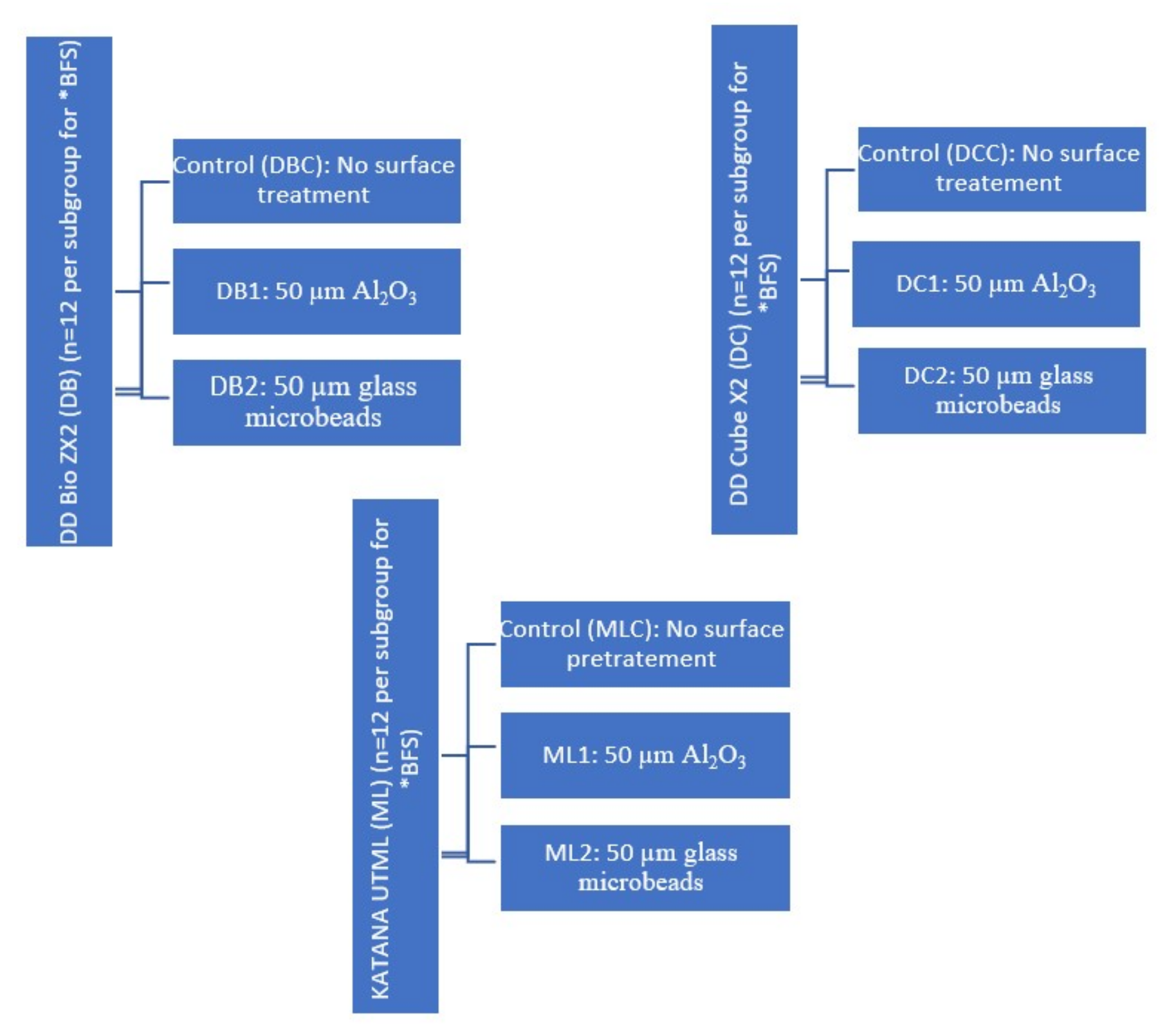
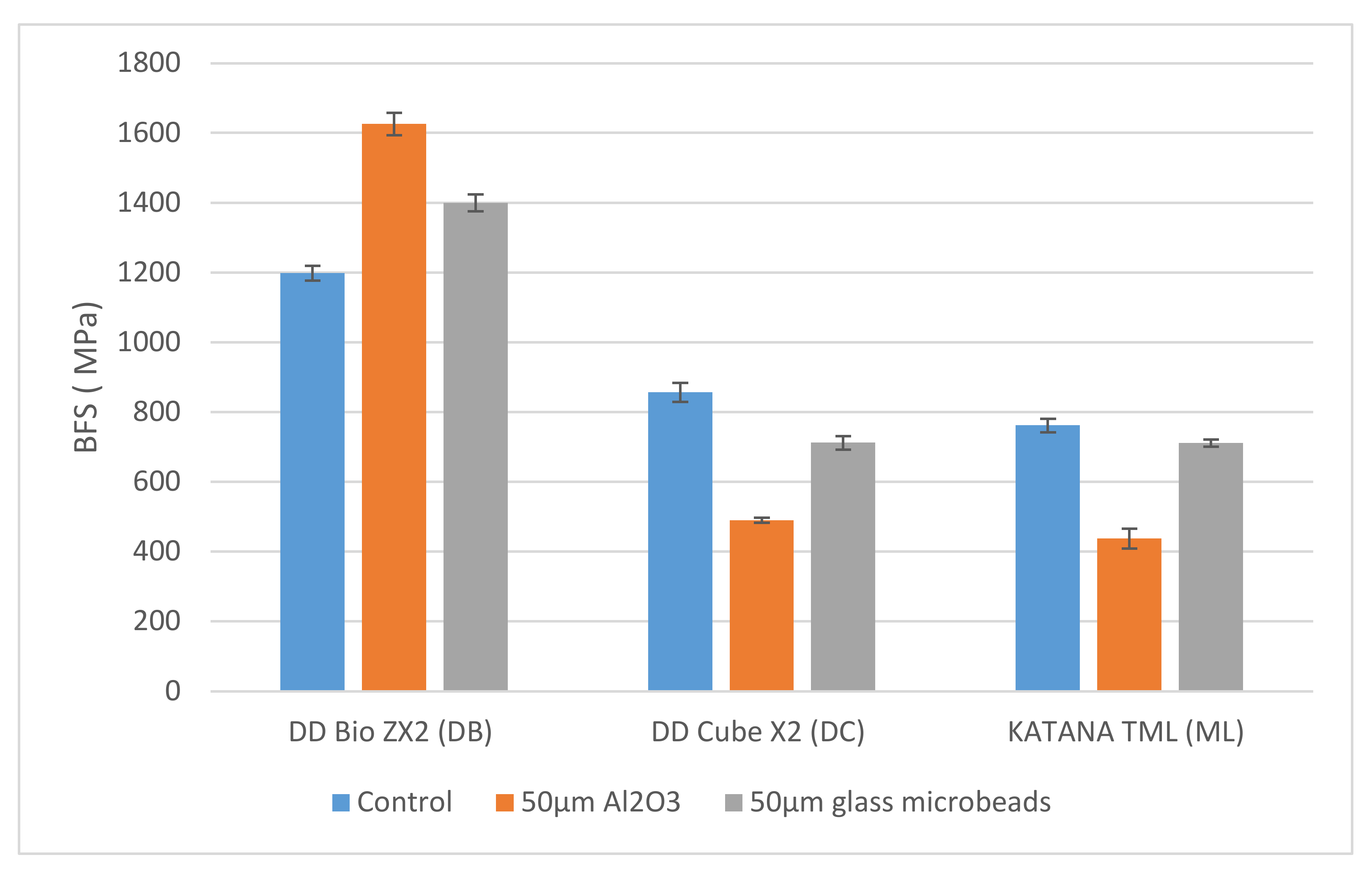

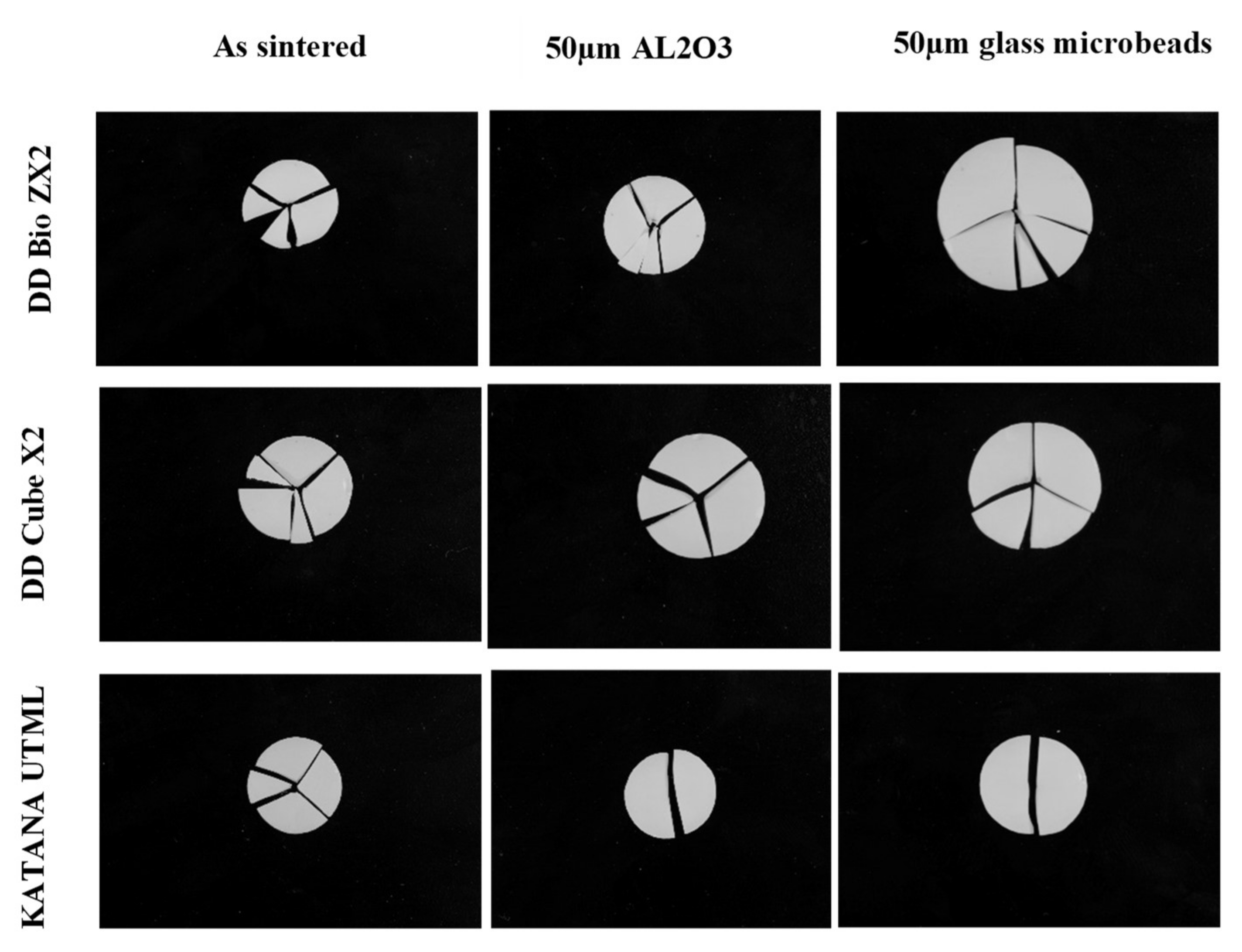
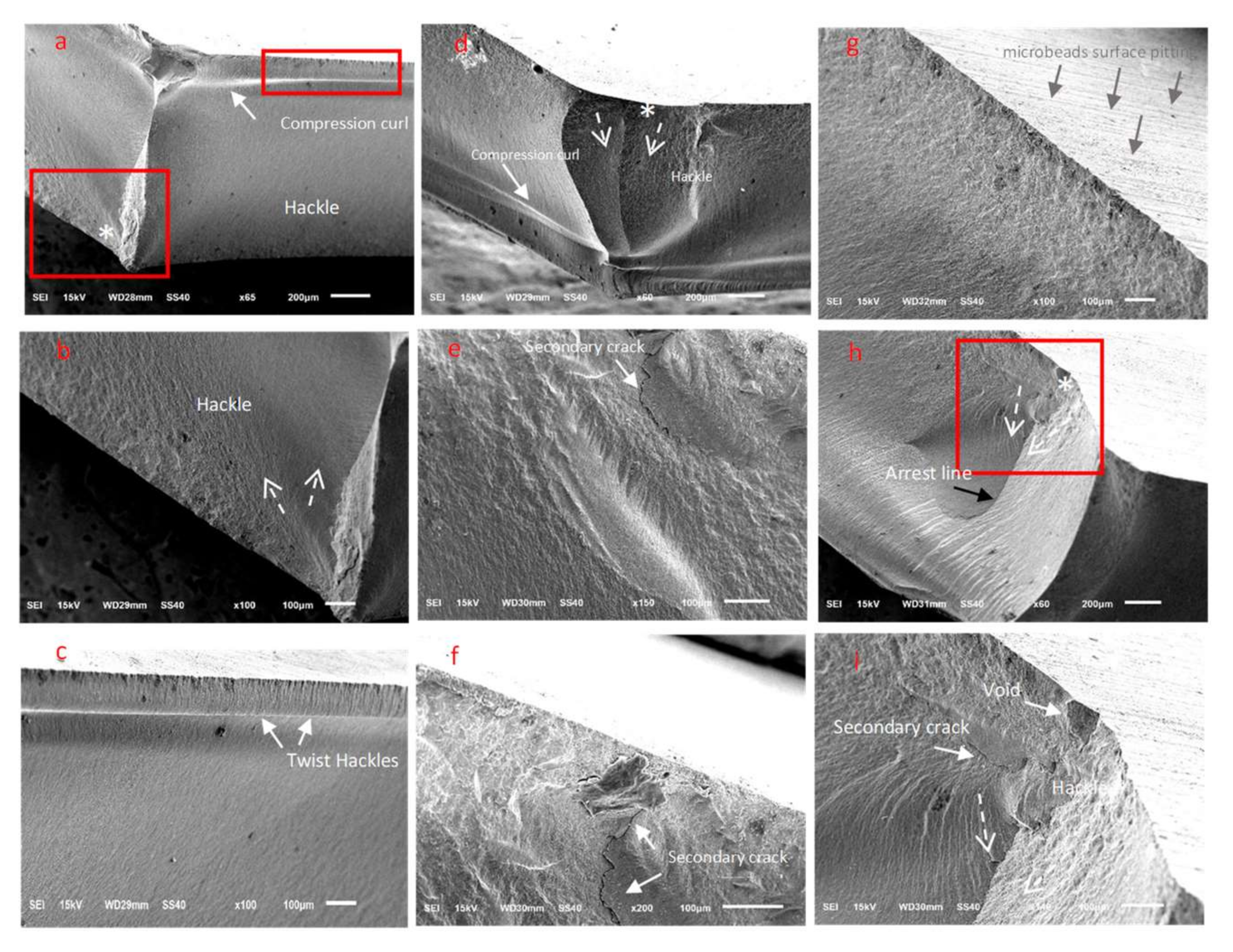
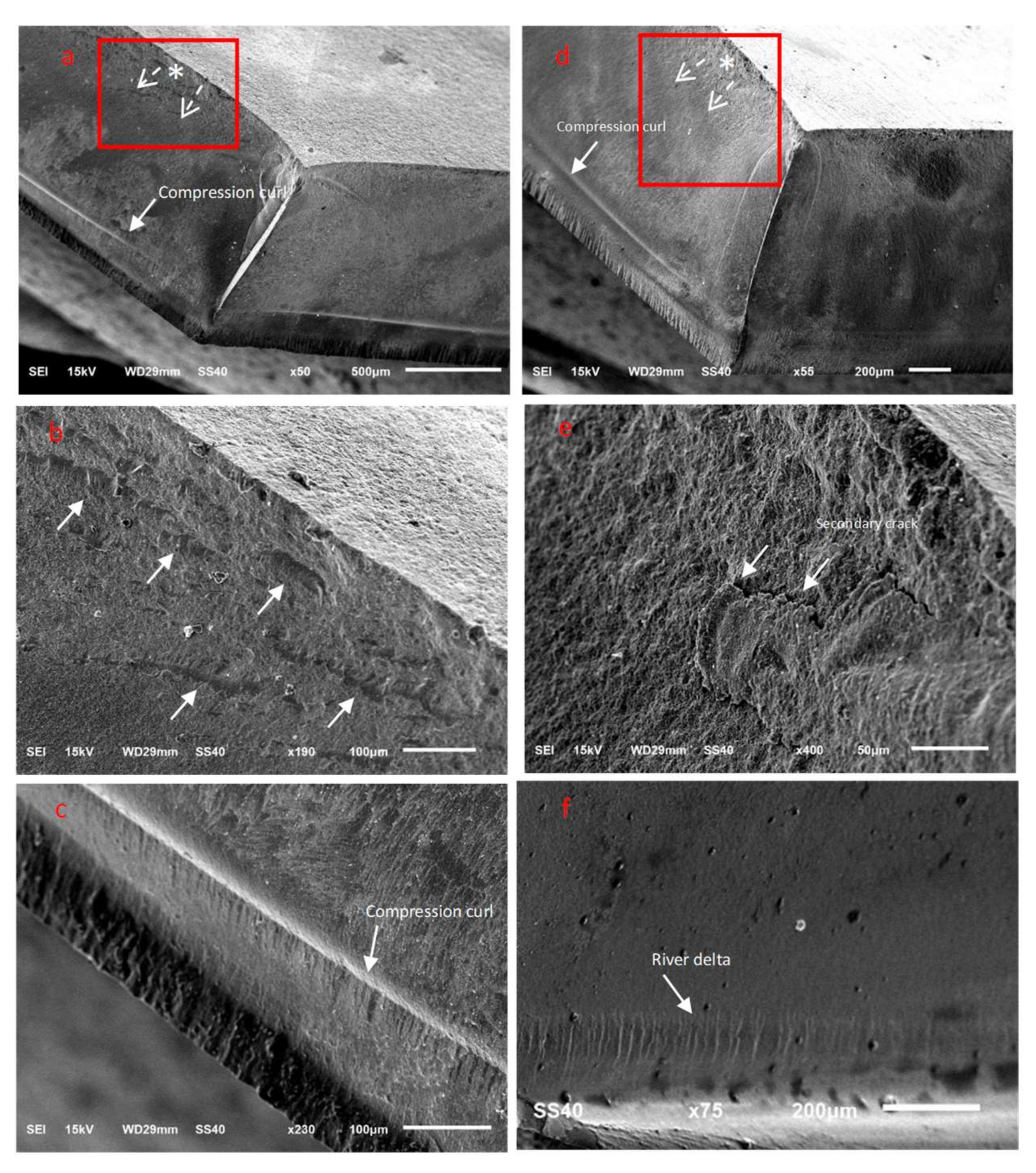

| Material | Brand Name | Shade | Composition | Manufacturer |
|---|---|---|---|---|
| High-translucent 3Y-TZP ceramic | DD Bio ZX2 | White | ≥99% ZrO2 + HfO2 + Y2O3, <6% Y2O3, ≤0.15% Al2O3, <1.0% other oxides. | Dental Direkt Materials, Germany |
| Superhigh-translucent 5Y-TZP ceramic | DD Cube X2 | White | ≥99% ZrO2 + HfO2 + Y2O3, <10% Y2O3, ≤0.01% Al2O3, <1.0% other oxides. | Dental Direkt Materials, Germany |
| Ultra-translucent 5Y-ZP ceramic | KATANA zirconia UTML | White | 87–92% ZrO2, 8–11% Y2O3, <2% other oxides. | Kuraray Noritake Dental, Tokyo, Japan |
| 50 µm glass microbead particles | Rolloblast | Glass microbeads | Renfert, Germany | |
| 50 µm aluminum oxide particles | Cobra | Aluminum oxide | Renfert, Germany |
| Material (Brand Name) | Sintering Temperature | Holding Time |
|---|---|---|
| DD Bio ZX2 | 1450 °C | 9 h |
| DD Cube X2 | 1450 °C | 9 h |
| KATANA zirconia UTML | 1550 °C | 2 h |
| Mean | Standard Deviation | Standard Error | 95% Confidence Interval for Mean | Min | Max | p Value | |||
|---|---|---|---|---|---|---|---|---|---|
| Lower Bound | Upper Bound | ||||||||
| DD Bio ZX2 (DB) | Control | 1198.52 c | 21.20 | 6.12 | 1185.05 | 1211.98 | 1162.09 | 1225.26 | 0.000 * |
| 50 µm Al2O3 | 1626.06 a | 31.94 | 9.22 | 1605.76 | 1646.35 | 1588.83 | 1676.23 | ||
| 50 µm glass microbeads | 1399.53 b | 24.25 | 7.00 | 1384.12 | 1414.94 | 1346.51 | 1439.88 | ||
| DD Cube X2 (DC) | Control | 856.73 a | 26.89 | 7.76 | 839.64 | 873.82 | 800.96 | 923.32 | 0.000 * |
| 50 µm Al2O3 | 490.40 c | 6.96 | 2.01 | 485.98 | 494.83 | 477.24 | 501.06 | ||
| 50 µm glass microbeads | 712.64 b | 19.38 | 5.59 | 700.32 | 724.95 | 687.15 | 740.27 | ||
| KATANA UTML (ML) | Control | 761.91 a | 19.44 | 5.61 | 749.55 | 774.26 | 728.21 | 789.29 | 0.000 * |
| 50 µm Al2O3 | 437.92 c | 29.57 | 8.54 | 419.12 | 456.71 | 396.21 | 487.36 | ||
| 50 µm glass microbeads | 711.76 b | 10.39 | 3.00 | 705.16 | 718.36 | 694.05 | 730.08 | ||
| DD Bio ZX2 (DB) | DD Cube X2 (DC) | KATANA UTML (ML) | |||||
|---|---|---|---|---|---|---|---|
| Mean Difference | p Value | Mean Difference | p Value | Mean Difference | p Value | ||
| 50 µm Al2O3 | 50 µm glass microbeads | 226.5240 * | 0.000 | −222.2337 * | 0.000 | −273.8480 * | 0.000 |
| Control | 427.5403 * | 0.000 | −366.3253 * | 0.000 | −323.9907 * | 0.000 | |
| 50 µm glass microbeads | Control | 201.0163 * | 0.000 | −144.0916 * | 0.000 | −50.1427 * | 0.000 |
Publisher’s Note: MDPI stays neutral with regard to jurisdictional claims in published maps and institutional affiliations. |
© 2021 by the authors. Licensee MDPI, Basel, Switzerland. This article is an open access article distributed under the terms and conditions of the Creative Commons Attribution (CC BY) license (https://creativecommons.org/licenses/by/4.0/).
Share and Cite
AlMutairi, R.; AlNahedh, H.; Maawadh, A.; Elhejazi, A. Effects of Different Air Particle Abrasion Protocols on the Biaxial Flexural Strength and Fractography of High/Ultra-Translucent Zirconia. Materials 2022, 15, 244. https://doi.org/10.3390/ma15010244
AlMutairi R, AlNahedh H, Maawadh A, Elhejazi A. Effects of Different Air Particle Abrasion Protocols on the Biaxial Flexural Strength and Fractography of High/Ultra-Translucent Zirconia. Materials. 2022; 15(1):244. https://doi.org/10.3390/ma15010244
Chicago/Turabian StyleAlMutairi, Reem, Hend AlNahedh, Ahmed Maawadh, and Ahmed Elhejazi. 2022. "Effects of Different Air Particle Abrasion Protocols on the Biaxial Flexural Strength and Fractography of High/Ultra-Translucent Zirconia" Materials 15, no. 1: 244. https://doi.org/10.3390/ma15010244
APA StyleAlMutairi, R., AlNahedh, H., Maawadh, A., & Elhejazi, A. (2022). Effects of Different Air Particle Abrasion Protocols on the Biaxial Flexural Strength and Fractography of High/Ultra-Translucent Zirconia. Materials, 15(1), 244. https://doi.org/10.3390/ma15010244






